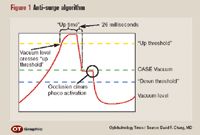Article
New phaco platform includes dual-pump fluidics
A new phacoemulsification system (WhiteStar Signature with Fusion Fluidics, Advanced Medical Optics) combines existing phaco technology with a dual-pump fluidics system designed to enhance chamber stability. In addition, the technology offers a streamlined user interface and accessories that aim to enhance the efficiency of the operating room.

Key Points
San Diego-A new phacoemulsification system (WhiteStar Signature with Fusion Fluidics, Advanced Medical Optics) features dual-pump fluidics in an effort to enhance chamber stability and provide greater surgeon flexibility, said David F. Chang, MD, describing the system at the American Society of Cataract and Refractive Surgery annual meeting, where it was introduced.

"The dual pump represents the next generation in phaco fluidics, and the new user interface is a substantial improvement for surgeons and staff," said Dr. Chang, clinical professor of ophthalmology, University of California, San Francisco, who also is in private practice in Los Altos, CA. He said he has performed 90 procedures with the new phaco system.
The dual pump, according to Dr. Chang, will not be released commercially until later this year.
"What is unique to this set-up is that the same pump can function either as a live vacuum venturi pump or a traditional peristaltic pump," he said. "Because it is the same pump with a single type of cassette tubing, the surgeon does not have to choose one pump module over another at the beginning of the case, but rather can switch back and forth between the two pump functions during the same operation."

"I strongly believe that using smaller, 20-gauge phaco tips decreases the chance of posterior capsule rupture," said Dr. Chang. "Now one could use a venturi pump to overcome the sluggishness of removing dense nuclear fragments with a micro phaco tip, and yet slow things down with a peristaltic pump for the final fragments, when the posterior capsule is exposed.
"One could then switch back to venturi unoccluded live vacuum to draw epinucleus toward the tip, instead of having to aspirate it so peripherally," he added. "By programming the two pump functions into the different memory settings, the surgeon can sequentially control all of this with the foot pedal."
Anti-surge algorithm
Another feature of the fluidics technology is what Dr. Chang calls an anti-surge algorithm, which recognizes occlusion and adjusts the maximum vacuum level downward before the occlusion break occurs. The algorithm reverses the pump to step-down the vacuum and can react in as few as 26 milliseconds. Breaking occlusion from a much lower vacuum level significantly reduces surge and augments chamber stability, he said.
When using a 20-gauge tip with this anti-surge algorithm, surge is reduced 56%, according to company bench tests.
"I have programmed my foot pedal so that I can turn this anti-surge algorithm on or off during the case," Dr. Chang said. "Like activating anti-lock brakes on a car, this algorithm automatically drops the vacuum level down after a pre-determined interval to prevent surge as I am aspirating fragments."
Other features of the fluidics technology include a one-step, auto-loading tubing pack; a faster prime cycle; a touch screen designed to be more intuitive; a wireless foot pedal; voice confirmation; and greater ease of programming.
The phaco system also offers a media program with real-time blending of system data and surgical video; customized viewing of procedures and data; high-definition, customizable presentation capability; and a frame-by-frame teaching tool.
Newsletter
Don’t miss out—get Ophthalmology Times updates on the latest clinical advancements and expert interviews, straight to your inbox.




